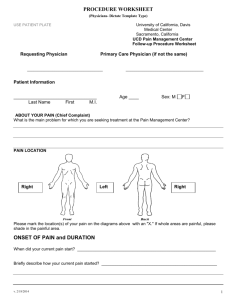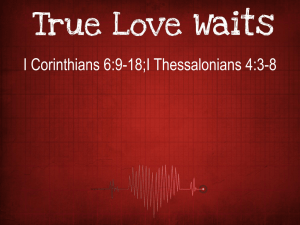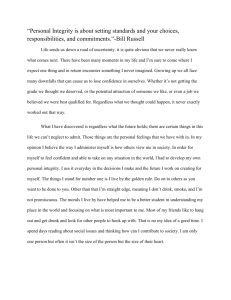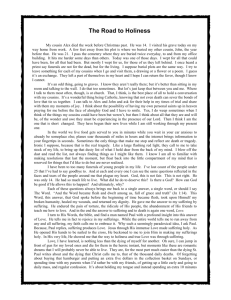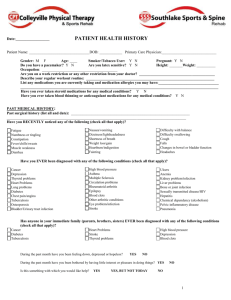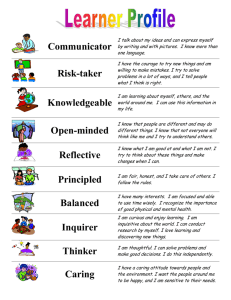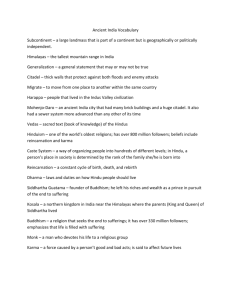The Pain Scale
advertisement
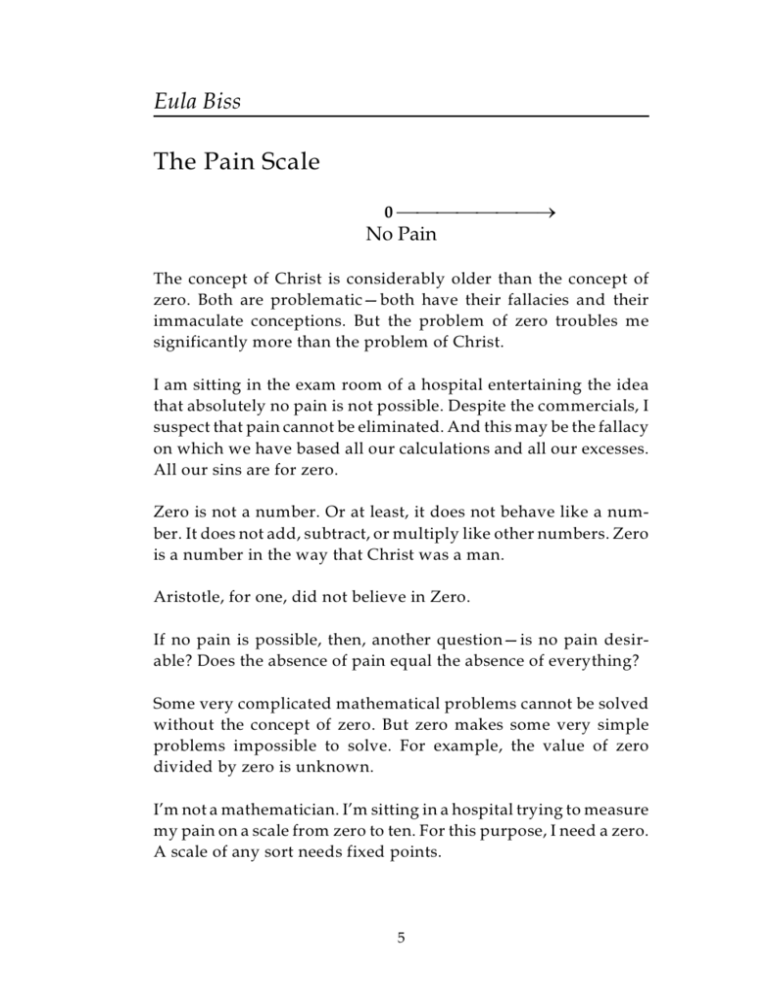
Eula Biss The Pain Scale 0 ¾¾¾¾¾¾¾® No Pain The concept of Christ is considerably older than the concept of zero. Both are problematic—both have their fallacies and their immaculate conceptions. But the problem of zero troubles me significantly more than the problem of Christ. I am sitting in the exam room of a hospital entertaining the idea that absolutely no pain is not possible. Despite the commercials, I suspect that pain cannot be eliminated. And this may be the fallacy on which we have based all our calculations and all our excesses. All our sins are for zero. Zero is not a number. Or at least, it does not behave like a number. It does not add, subtract, or multiply like other numbers. Zero is a number in the way that Christ was a man. Aristotle, for one, did not believe in Zero. If no pain is possible, then, another question—is no pain desirable? Does the absence of pain equal the absence of everything? Some very complicated mathematical problems cannot be solved without the concept of zero. But zero makes some very simple problems impossible to solve. For example, the value of zero divided by zero is unknown. I’m not a mathematician. I’m sitting in a hospital trying to measure my pain on a scale from zero to ten. For this purpose, I need a zero. A scale of any sort needs fixed points. 5 The upper fixed point on the Fahrenheit scale, ninety-six, is based on a slightly inaccurate measure of normal body temperature. The lower fixed point, zero, is the coldest temperature at which a mixture of salt and water can still remain liquid. I myself am a mixture of salt and water. I strive to remain liquid. Zero, on the Celsius scale, is the point at which water freezes. And one hundred is the point at which water boils. But Anders Celsius, who introduced the scale in 1741, originally fixed zero as the point at which water boiled, and one hundred as the point at which water froze. These fixed points were reversed only after his death. The deepest circle of Dante’s Inferno does not burn. It is frozen. In his last glimpse of Hell, Dante looks back and sees Satan upside down through the ice. There is only one fixed point on the Kelvin scale—absolute zero. Absolute zero is 273 degrees Celsius colder than the temperature at which water freezes. There are zeroes beneath zeroes. Absolute zero is the temperature at which molecules and atoms are moving as slowly as possible. But even at absolute zero, their motion does not stop completely. Even the absolute is not absolute. This is comforting, but it does not give me faith in zero. At night, I ice my pain. My mind descends into a strange sinking calm. Any number multiplied by zero is zero. And so with ice and me. I am nullified. I wake up to melted ice and the warm throb of my pain returning. Grab a chicken by its neck or body—it squawks and flaps and pecks and thrashes like mad. But grab a chicken by its feet and turn it upside down, and it just hangs there blinking in a waking trance. Zeroed. My mother and I hung the chickens like this on the barn door for their necks to be slit. I like to imagine that a chicken at zero feels no pain. 6 ¬¾¾¾¾¾¾¾1¾¾¾¾¾¾¾® Major things are wind, evil, a good fighting horse, prepositions, inexhaustible love, the way people choose their king. Minor things include dirt, the names of schools of philosophy, mood and not having a mood, the correct time. There are more major things than minor things overall, yet there are more minor things than I have written here, but it is disheartening to list them. . . . —Anne Carson My father is a physician. He treats patients with cancer, who often suffer extreme pain. My father raised me to believe that most pain is minor. He was never impressed by my bleeding cuts or even my weeping sores. In retrospect, neither am I. Every time I go to the doctor and every time I visit the physical therapist, I am asked to rate my pain on a scale from zero to ten. This practice of quantifying pain was introduced by the hospice movement in the 1970s, with the goal of providing better care for patients who did not respond to curative treatment. My father once told me that an itch is just very mild pain. Both sensations simply signal, he told me, irritated or damaged tissue. But a nasty itch, I observed, can be much more excruciating than a paper cut, which is also mild pain. Digging at an itch until it bleeds and is transformed into pure pain can bring a kind of relief. Where does pain worth measuring begin? With poison ivy? With a hang nail? With a stubbed toe? A sore throat? A needle prick? A razor cut? When I complained of pain as a child, my father would ask, “What kind of pain?” Wearily, he would list for me some of the different kinds of pain, “Burning, stabbing, throbbing, prickling, dull, sharp, deep, shallow . . .” 7 Hospice nurses are trained to identify five types of pain: physical, emotional, spiritual, social, and financial. The pain of feeling, the pain of caring, the pain of doubting, the pain of parting, the pain of paying. Overlooking the pain of longing, the pain of desire, the pain of sore muscles, which I find pleasurable . . . The pain of learning, and the pain of reading. The pain of trying. The pain of living. A minor pain or a major pain? There is a mathematical proof that zero equals one. Which, of course, it doesn’t. 8 ¬¾¾¾¾¾¾¾2¾¾¾¾¾¾¾® The set of whole numbers is also known as “God’s numbers.” The devil is in the fractions. Although the distance between one and two is finite, it contains infinite fractions. This could also be said of the distance between my mind and my body. My one and my two. My whole and its parts. The sensations of my own body may be the only subject on which I am qualified to claim expertise. Sad and terrible, then, how little I know. “How do you feel?” the doctor asks, and I cannot answer. Not accurately. “Does this hurt?” he asks. Again, I’m not sure. “Do you have more or less pain than the last time I saw you?” Hard to say. I begin to lie to protect my reputation. I try to act certain. The physical therapist raises my arm above my head. “Any pain with this?” she asks. Does she mean any pain in addition to the pain I already feel, or does she mean any pain at all? She is annoyed by my question. “Does this cause you pain?” she asks curtly. No. She bends my neck forward, “Any pain with this?” No. “Any pain with this?” No. It feels like a lie every time. On occasion, an extraordinary pain swells like a wave under the hands of the doctor, or the chiropractor, or the massage therapist, and floods my body. Sometimes I hear my throat make a sound. Sometimes I see spots. I consider this the pain of treatment, and I have come to find it deeply pleasurable. I long for it. The International Association for the Study of Pain is very clear on this point—pain must be unpleasant. “Experiences which resemble pain but are not unpleasant,” reads their definition of pain, “should not be called pain.” In the second circle of Dante’s Inferno, the adulterous lovers cling to each other, whirling eternally, caught in an endless wind. My 9 next-door neighbor, who loves Chagall, does not think this sounds like Hell. I think it depends on the wind. Wind, like pain, is difficult to capture. The poor windsock is always striving, and always falling short. It took sailors more than two hundred years to develop a standardized numerical scale for the measure of wind. The result, the Beaufort scale, provides twelve categories for everything from “Calm” to “Hurricane.” The scale offers not just a number, but a term for the wind, a range of speed, and a brief description. A force 2 wind on the Beaufort scale, for example, is a “Light Breeze” moving between four and seven miles per hour. On land, it is specified as “wind felt on face; leaves rustle; ordinary vanes moved by wind.” 10 ¬¾¾¾¾¾¾¾3¾¾¾¾¾¾¾® Left alone in the exam room I stare at the pain scale, a simple number line complicated by only two phrases. Under zero: “no pain.” Under ten: “the worst pain imaginable.” The worst pain imaginable . . . Stabbed in the eye with a spoon? Whipped with nettles? Buried under an avalanche of sharp rocks? Impaled with hundreds of nails? Dragged over gravel behind a fast truck? Skinned alive? My father tells me that some things one might expect to be painful are not. I have read that starving to death, at a certain point, is not exactly painful. At times, it may even cause elation. Regardless, it is my sister’s worst fear. She would rather die any other way, she tells me. I do not prefer one death over another. Perhaps this is because I am incapable of imagining the worst pain imaginable. Just as I am incapable of actually understanding calculus, although I could once perform the equations correctly. Like the advanced math of my distant past, determining the intensity of my own pain is a blind calculation. On my first attempt, I assigned the value of ten to a theoretical experience—burning alive. Then I tried to determine what percentage of the pain of burning alive I was feeling. I chose thirty percent—three. Which seemed, at the time, quite substantial. Three. Mail remains unopened. Thoughts are rarely followed to their conclusions. Sitting still becomes unbearable after one hour. Nausea sets in. Grasping at the pain does not bring relief. Quiet desperation descends. “Three is nothing,” my father tells me now. “Three is go home and take two aspirin.” 11 It would be helpful, I tell him, if that could be noted on the scale. The four vital signs used to determine the health of a patient are blood pressure, temperature, breath, and pulse. Recently, it has been suggested that pain be considered a fifth vital sign. But pain presents a unique problem in terms of measurement, and a unique cruelty in terms of suffering—it is entirely subjective. Assigning a value to my own pain has never ceased to feel like a political act. I am a citizen of a country that ranks our comfort above any other concern. People suffer, I know, so that I may eat bananas in February. And then there is history . . . I struggle to consider my pain in proportion to the pain of a napalmed Vietnamese girl whose skin is slowly melting off as she walks naked in the sun. This exercise itself is painful. “You are not meant to be rating world suffering,” my friend in Honduras advises. “This scale applies only to you and your experience.” At first, this thought is tremendously relieving. It unburdens me of factoring the continent of Africa into my calculations. But the reality that my nerves alone feel my pain is terrifying. I hate the knowledge that I am isolated in this skin—alone with my pain and my own fallibility. 12 ¬¾¾¾¾¾¾¾4¾¾¾¾¾¾¾® The Wong-Baker Faces scale was developed to help young children rate their pain. The face I remember, always, was on the front page of a local newspaper in an Arizona gas station. The man’s face was horrifyingly distorted in an open-mouthed cry of raw pain. His house, the caption explained, had just been destroyed in a wildfire. But the man himself, the article revealed, had not been hurt. Several studies have suggested that children using the WongBaker scale tend to conflate emotional pain and physical pain. A child who is not in physical pain but is very frightened of surgery, for example, might choose the crying face. One researcher observed that “hurting” and “feeling” seemed to be synonymous to some children. I myself am puzzled by the distinction. Both words are used to describe emotions as well as physical sensations, and pain is defined as a “sensory and emotional experience.” In an attempt to rate only the physical pain of children, a more emotionally “neutral” scale was developed. A group of adult patients favored the Wong-Baker scale in a study comparing several different types of pain scales. The patients were asked to identify the easiest scale to use by rating all the scales on a scale from zero, “not easy,” to six, “easiest ever seen.” The 13 patients were then asked to rate how well the scales represented pain on a scale from zero, “not good,” to six, “best ever seen.” The patients were not invited to rate the experience of rating. I stare at a newspaper photo of an Israeli boy with a bloodstained cloth wrapped around his forehead. His face is impassive. I stare at a newspaper photo of a prisoner standing delicately balanced with electrodes attached to his body, his head covered with a hood. No face, no pain? A crying baby, to me, always seems to be in the worst pain imaginable. But when my aunt became a nurse twenty years ago, it was not unusual for surgery to be done on infants without any pain medication. Babies, it was believed, did not have the fully developed nervous systems necessary to feel pain. Medical evidence that infants experience pain in response to anything that would cause an adult pain has only recently emerged. There is no evidence of pain on my body. No marks. No swelling. No terrible tumor. The X-Rays revealed nothing. Two MRIs of my brain and spine revealed nothing. Nothing was infected and festering, as I had suspected and feared. There was no ghastly huge white cloud on the film. There was nothing to illustrate my pain except a number, which I was told to choose from between zero and ten. My proof. 14 ¬¾¾¾¾¾¾¾5¾¾¾¾¾¾¾® “The problem with scales from zero to ten,” my father tells me, “is the tyranny of the mean.” Overwhelmingly, patients tend to rate their pain as a five, unless they are in excruciating pain. At best, this renders the scale far less sensitive to gradations in pain. At worst, it renders the scale useless. I understand the desire to be average only when I am in pain. To be normal is to be okay in a fundamental way—to be chosen numerically by God. When I could no longer sleep at night because of my pain, my father reminded me that a great many people suffer from both insomnia and pain. “In fact,” he told me, “neck and back pain is so common that it is a cliché—a pain in the neck!” The fact that 50 million Americans suffer from chronic pain does not comfort me. Rather, it confounds me. “This is not normal,” I keep thinking. A thought invariably followed by a doubt, “Is this normal?” The distinction between test results that are normal or abnormal is often determined by how far the results deviate from the mean. My X-rays did not reveal a cause for my pain, but they did reveal an abnormality. “See this,” the doctor pointed to the string of vertebrae hanging down from the base of my skull like a loose line finding plumb. “Your spine,” he told me, “is abnormally straight.” I live in Middle America. I am of average height, although I have always thought of myself as short. I am of average weight, although I tend to believe I am oddly shaped. Although I try to hide it, I have long straight blond hair, like most of the women in this town. 15 Despite my efforts to ignore it and to despise it, I am still susceptible to the mean—a magnet that pulls even flesh and bone. For some time I entertained the idea that my spine might have been straightened by my long-held misconception that normal spines were perfectly straight. Unknowingly, I may have been striving for a straight spine, and perhaps I had managed to disfigure my body by sitting too straight for too many years. “Unlikely,” the doctor told me. 16 ¬¾¾¾¾¾¾¾6¾¾¾¾¾¾¾® A force 6 wind on the Beaufort scale, a “Strong Breeze,” is characterized by, “large branches in motion; telegraph wires whistle; umbrellas used with difficulty.” Over a century before preliminary scales were developed to quantify the wind, serious efforts were made to produce an accurate map of Hell. Infernal cartography was considered an important undertaking for the architects and mathematicians of the Renaissance, who based their calculations on the distances and proportions described by Dante. The exact depth and circumference of Hell inspired intense debates, despite the fact that all calculations, no matter how sophisticated, were based on a work of fiction. Galileo Galilei delivered extensive lectures on the mapping of Hell. He applied recent advances in geometry to determine the exact location of the entrance to the underworld and then figured the dimensions that would be necessary to maintain the structural integrity of Hell’s interior. It was the age of the golden rectangle—the divine proportion. Mathematics revealed God’s plan. But the very use of numbers required a religious faith, because one could drop off the edge of the earth at any point. The boundaries of the maps at that time faded into oceans full of monsters. Imagination is treacherous. It erases distant continents, it builds a Hell so real that the ceiling is vulnerable to collapse. To be safe, I think I should only map my pain in proportion to pain I have already felt. But my nerves have short memories. My mind remembers crashing my bicycle as a teenager, but my body does not. I cannot seem to conjure the sensation of lost skin without actually losing skin. My nerves cannot, or will not, imagine past pain—this, I think, is for the best. Nerves simply register, they do not invent. 17 After a year of pain, I realized that I could no longer remember what it felt like not to be in pain. I was left anchorless. I tended to think of the time before the pain as easier and brighter, but I began to suspect myself of fantasy and nostalgia. Although I cannot ask my body to remember feeling pain it does not feel, and I cannot ask it to remember not feeling pain it does feel, I have found that I can ask my body to imagine the pain it feels as something else. For example, with some effort I can imagine the sensation of pain as heat. Perhaps, with a stronger mind, I could imagine the heat as warmth, and then the warmth as nothing at all. 18 ¬¾¾¾¾¾¾¾7¾¾¾¾¾¾¾® I accidentally left a burner on the stove going for two and a half days—a small blue flame, burning, burning, burning . . . The duration terrified me. How incredibly dangerous, so many hours of fire. I would happily cut off a finger at this point, if I could trade the pain of that cut for the endless pain I have now. When I cry from it, I cry over the idea of it lasting forever, not over the pain itself. The psychologist, in her rational way, suggests that I do not let myself imagine it lasting forever. “Choose an amount of time that you know you can endure,” she suggests, “and then challenge yourself only to make it through that time.” I make it through the night, and then sob through half the morning. The pain scale measures only the intensity of pain, not the duration. This may be its greatest flaw. A measure of pain, I believe, requires at least two dimensions. The suffering of Hell is terrifying not because of any specific torture, but because it is eternal. The square root of seven results in a decimal that repeats randomly into infinity. The exact figure cannot be known, only a close approximation. Rounding a number to the nearest significant figure is a tool designed for the purpose of making measurements. The practicality of rounding is something my mind can fully embrace. No measurement is ever exact, of course. Seven is the largest prime number between zero and ten. Out of all the numbers, the very largest primes are unknown. Still, every year, the largest known prime is larger. Euclid proved the number of primes to be infinite, but the infinity of primes is slightly smaller than the infinity of the rest of the numbers. It is here, exactly at this point, that my ability to comprehend begins to fail. 19 ¬¾¾¾¾¾¾¾8¾¾¾¾¾¾¾® Although all the numbers follow each other in a predictable line, many unknown quantities exist. I do not know how long I have been clenching my teeth when I notice that I am clenching my teeth. My mind, apparently, has not been with my body. I wonder why, when I most want to, I cannot seem to keep my mind from my body. I no longer know who I am, or if I am in charge of myself. Experts do not know why some pain resolves and other pain becomes chronic. One theory is that the body begins to react to its own reaction, trapping itself in a cycle of its own pain response. This can go on indefinitely, twisting like the figure eight of infinity. My father tells me that when he broke his collarbone it didn’t hurt. I would like to believe this, but I am suspicious of my father’s assessment of his own pain. The problem of pain is that I cannot feel my father’s, and he cannot feel mine. This, I suppose, is also the essential mercy of pain. Several recent studies have suggested that women feel pain differently than men. Further studies have suggested that pain medications act differently on women than they do on men. I am suspicious of these studies, so favored by Newsweek, and so heaped upon waiting room tables. I dislike the idea that our flesh is so essentially unique that it does not even register pain as a man’s flesh does—a fact that renders our bodies, again, objects of supreme mystery. But I am comforted, oddly, by the possibility that you cannot compare my pain to yours. And, for that reason, cannot prove it insignificant. 20 The medical definition of pain specifies the “presence or potential of tissue damage.” Pain that does not signal tissue damage is not, technically, pain. “This is a pathology,” the doctor assured me when he informed me that there was no definitive cause of my pain, no effective treatment for it, and very probably no end to it. “This is not in your head.” It would not have occurred to me to think that I was imagining the pain. But the longer the pain persisted, and the harder it became for me to imagine what it was like not to be in pain, the more seriously I considered the disturbing possibility that I was not, in fact, in pain. Another theory of chronic pain is that it is a faulty message sent by malfunctioning nerves. “For example,” the Mayo Clinic suggests, “your pain could be similar to the phantom pain some amputees feel in their amputated limbs.” I walked out of a lecture on chronic pain after too many repetitions of the phrase, “We have reason to believe that you are in pain, even if there is no physical evidence of your pain.” I had not realized that the fact that I believed myself to be in pain was not reason enough. We have reason to believe in infinity, but everything we know ends. 21 ¬¾¾¾¾¾¾¾9¾¾¾¾¾¾¾® “I have a very high pain threshold,” my mother mentions casually. This is undoubtedly true. I stand by uselessly and cover my ears as my mother, a very small woman, lifts the blunt end of a pick axe over her head and slams it down on a metal pipe she is driving into the frozen ground. Any portrait of my mother should include a blue-black fingernail. “I breathe, I have a heartbeat, I have pain . . .” I repeat to myself as I lie in bed at night. I am striving to adopt the pain as a vital sensation. My mother, I know, has already mastered this exercise. Her existence, like my father’s, pains me. This is the upper fixed point of love. Once, for a study of chronic pain, I was asked to rate not just my pain, but also my suffering. I rated my pain as a three. Having been sleepless for nearly a week, I rated my suffering as a seven. “Pain is the hurt, either physical or emotional, that we experience,” writes the Reverend James Chase. “Suffering is the story we tell ourselves of our pain.” Yes, suffering is the story we tell ourselves. “At the moment we are devoid of any standard criteria as to what constitutes suffering,” Reverend Chase writes in his paper on genetic therapy, which is more a meditation on suffering. “Since we do not have agreed-upon criteria, it would be negligent to make decisions for others regarding suffering. We might be able to answer this for ourselves, but not for others. . . . “If we come to the point where we have no place for suffering, to what lengths will we go to eradicate it? Will we go so far as to inflict suffering to end it?” 22 Christianity is not mine. I do not know it and I cannot claim it. But I’ve seen the sacred heart ringed with thorns, the gaping wound in Christ’s side, the weeping virgin, the blood, the nails, the cross to bear . . . Pain is holy, I understand. Suffering is di-vine. In my worst pain, I can remember thinking, “This is not beautiful.” I can remember being disgusted by the very idea. But in my worst pain, I also found myself secretly cherishing the phrase, “This too shall pass.” The longer the pain lasted, the more beautiful and impossible and absolutely holy this phrase became. 23 ¬¾¾¾¾¾¾¾10 The Worst Pain Imaginable Through a failure of my imagination, or of myself, I have discovered that the pain I am in is always the worst pain imaginable. But I would like to believe that there is an upper limit to pain. That there is a maximum intensity nerves can register. There is no tenth circle in Dante’s Hell. The digit ten depends on the digit zero, in our current number system. In 1994 Robert Forslund developed an Alternative Number System. “This system,” he wrote with triumph, “eliminates the need for the digit zero, and hence all digits behave the same.” In the Alternate Number System, the tenth digit is represented by the character A. Counting begins at one: 1, 2, 3, 4, 5, 6, 7, 8, 9, A, 11, 12 . . . 18, 19, 1A, 21, 22 . . . 28, 29, 2A . . . 98, 99, 9A, A1, A2, A3, A4, A5, A6, A7, A8, A9, AA, 111, 112 . . . “One of the functions of the pain scale,” my father explains, “is to protect doctors—to spare them some emotional pain. Hearing someone describe their pain as a ten is much easier than hearing them describe it as a hot poker driven through their eyeball into their brain.” A better scale, my father thinks, might rate what patients would be willing to do to relieve their pain. “Would you,” he suggests, “visit five specialists and take three prescription narcotics?” I laugh because I have done just that. “Would you,” I offer, “give up a limb?” I would not. “Would you surrender your sense of sight for the next ten years?” my father asks. I would not. “Would you accept a shorter life span?” I might. We are laughing, having fun with this game. But later, reading statements collected by the American Pain Foundation, I am alarmed by the number of references to suicide. 24 “. . . constant muscle aches, spasms, sleeplessness, pain, can’t focus . . . must be depression . . . two suicide attempts later, electroshock therapy and locked-down wards. . . .” The description of hurricane force winds on the Beaufort scale is simply, “devastation occurs.” Bringing us, of course, back to zero. 25
